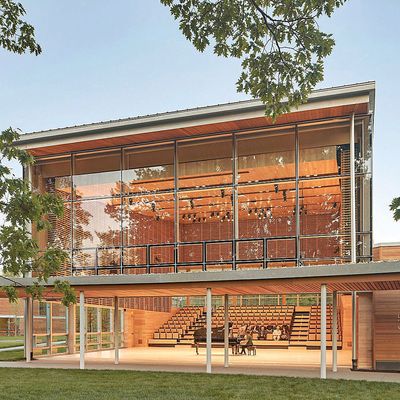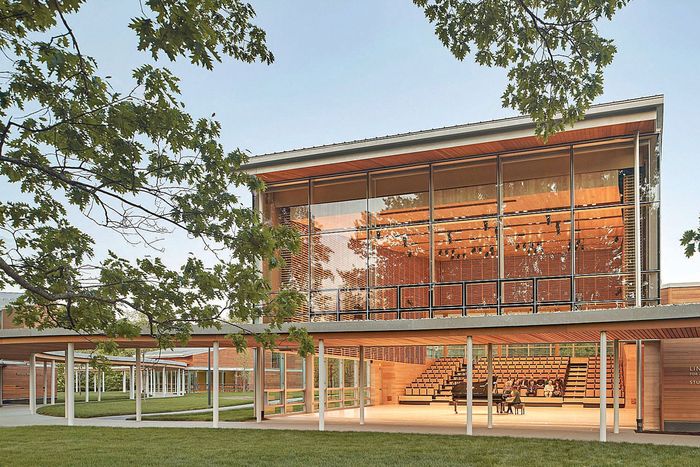
The Berkshires, the bucolic swath of Western Massachusetts where urban refugees can get their weekend dose of gardens, waterfalls, and even the occasional moose sighting, enjoys the cultural life of a major city, spread out over an area half again as vast as Houston. Though it mostly hibernates in winter, you could spend a week in summer darting from town to town and vacuuming up modern dance, early music, popular illustration, Broadway-level theater, and, in a couple of years, “extreme model railroads and contemporary architecture.” These aren’t sleepy amateur operations, either, but major institutions that are constantly, and expensively, renewing themselves, deploying new architecture in their competition to be the area’s main artistic attraction.
The county’s cultural King Kong is Tanglewood, where the campus’ iconic location isn’t a building at all but the lawn, where live orchestral music wafts from the shed, seasoning thousands of picnics. The experience of outdoor music is the product of some deftly self-effacing architecture, especially the open-sided Koussevitsky Music Shed from 1938 and William Rawn’s 1994 Seiji Ozawa Hall, a warm, barrel-vaulted concert jewel, opens to the breeze at one narrow end. Now Rawn has created the Linde Center, which consists of a Goldilocks trio of studios — one large, one small, and one just right — all with windows and walls that can let birdcalls in and Beethoven out. They are linked by a sinuous breezeway that steers a course around an old red oak. Wouldn’t it be great if more architecture were organized around music and trees?
Rawn’s design is a distant echo of Sanaa’s Grace Farms, in New Canaan, Connecticut, where a slender canopy snakes up a hill, sweeping by several almost invisible pavilions. But Rawn’s double-height, one-story buildings, clad in red cedar, are brawnier, bulkier, and more rugged. Elegant without being precious, rustic but not picturesque, they make the point that art requires labor, and that the most practical décor for a workshop is high ceilings and plenty of light. These rooms function like high-end musical toolboxes. Seats slide out and stow away, pianos roll through wide doorways, curtains and acoustic panels glide on tracks to block out daylight and bucolic views, all to create a chain of linked and flexible spaces for rehearsals, performances, classes, and talks. On the morning I visited, a crew was setting up for that evening’s performance of John Cage’s Song Books and film clip showing, so that audience members and performers could scatter through the halls and out on the grass, singing, and playing and listening across thresholds and through walls.
The Linde Center turns a legendary summertime mecca into a year-round presence. Even when the lawn is snowed under and the shed is dormant, the Rawn’s S-M-L trio will provide a warm hearth of music for those who remain long after the lawn crowd has packed up their picnic baskets and gone home. That’s not the only addition in the area that aspires to transform an institution. In the former industrial town of North Adams, the Cambridge-based firm Bruner/Cott has helped Mass MoCA (the Massachusetts Museum of Contemporary Art) grow into a motley colossus, one of the world’s great centers of contemporary art. And an expansion of the Clark Art Institute in Williamstown, by the Japanese architect Tadao Ando, has turned a fine local museum into a destination worthy of a pretty long trek. The Berkshires’ major players have done a fine job selecting architects and — even more crucial — expressing clearly what they need and want. The most basic ingredient of good architecture is a good client.
Mass MoCA launched its gradual expansion 25 years ago, but instead of building out or up, it has grown into its disused factory, a complex the size of a medieval castle, complete with workshops, courtyards, and refectory. Today, with a quarter-million square feet of exhibition space spread out among 26 buildings, it is so vast and varied that it feels like an entire city neighborhood. The results look spectacularly casual at first, as if museum staffers had just cut through the dead factory’s fence, swept up the old beer bottles, and hung some art.
It’s a tour de force of invisible transformation. The eye lingers on columns scarred and mottled with age, warped ceiling planks, bricks that have been painted, scoured, gouged, ripped out, and replaced. The hallmark of 19th-century industrial facilities is that they could take plenty of abuse, and at Mass MoCA, the husk of Sprague Electric is still being beat up for art’s sake. The result is a refreshing mixture of irreverence and respect, playfulness, and high purpose.
Industrial chic is often a picturesquely weathered costume for a generically fussy place. Mass MoCA, though, was built to take punishment, absorb crowds, and uncorset artists’ imaginations. Children don’t need much of a nudge to go sprinting through Building 5, the immense central hall lit like a basilica from clerestory windows. Imagine the thrill when they find a like-minded artist like Trenton Doyle Hancock, a 45-year-old man still translating the superhero doodles of his 10-year-old self into a vast three-dimensional cosmology of made-up action figures and actual board games.
I happened to visit during Bang on a Can’s LOUD Festival, which occupied spaces scattered all over the complex. Resonant drone music from Canada whomped through the Hancock show, making his installations seems even more surreal. Hans Abrahamsen’s Schnee (Snow), in which a large ensemble makes very small sounds, whispered bewitchingly in a more formal auditorium. Afterward, in an open-sided building, the avant-garde techno-priestess Pamela Z. sang along with gizmos she waved at but didn’t touch, producing a dense, dreamy polyphony that wafted into the courtyard. I’ve rarely witnessed such a seamless melding of art and music, so that two distinct audiences cross, mingle, and separate again almost without noticing.
The latest addition, Building 6, opened two years ago, and instantly looked as grizzled and exciting as the rest. Coming across it was like walking through a closet and emerging in an unsuspected palace: the arrowhead-shaped building shoots toward a sun-filled point where a double-height atrium overlooks the Hoosic River. The space feels like a declaration of optimistic engagement. Not every show at Mass MoCA is superb, or even passable, but when an exhibit fails it usually does so with panache.
The Clark offers a completely different aesthetic experience, a perfectionist’s pursuit of the sublime. Where Mass MoCA glories in eclecticism, gaudiness, and visible joins, Ando, who dramatically expanded the Clark in 2014, welded together two incompatible buildings so smoothly they almost disappear. The first is Daniel Perry’s 1955 white marble temple, lifted on its own little hill and designed to function as a museum but feel like a mansion. That was followed 18 years and a couple of stylistic swerves later by Pietro Belluschi’s blocky pink-granite Manton Research Center, which became the principal entrance. Annabelle Selldorf has refurbished the interiors of both in her distinctive brand of super-premium moderne: walls painted aubergine, weighty hardware, track lighting galore, and doorways one could waft through if one wafted.
But while paintings fill one building and scholars keep the other one humming, Ando gives only a grudging nod to both. A long wall of Belluschi’s pink granite plunges from the sugar-cube temple into the museum’s new heart and shoots out the other side to form the edge of a reflecting pool before speeding off into a meadow as if it had forgotten to take the rest of the building with it. Ando’s collaboration with the landscape designers Reed Hildebrand energized him more than any architectural context. The thin roof appears to be floating free of the glass and concrete walls, which in turn skims the surface of the water and rests lightly on the meadowed hills. (In reality, the museum burrows rather than levitate: most of the new galleries are underground, where they allow visitors to exclude distractions and focus on paintings.)
With a few straight lines — and plenty of invisible engineering — Ando has bound art to landscape. A looping footpath leads up to Ando’s previous addition, the spare and elegant Lunder Center, where a pair of galleries sits nestled in the woods. But you can stay put and still have the near-total experience. The arrangement of satiny surfaces, flat water, and deep shadows can produce exhilarating effects, even outside the galleries. On my most recent visit, I watched concrete-colored storm clouds roll by overhead, pocking the pool, spattering a freestanding wall, and turning the whole complex into a minimalist study in gray and black. Half an hour spent sitting by the shallow pool among these artfully controlled planes restores even the most battered serenity.































